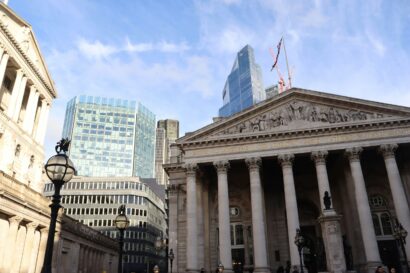AG INSIGHT | 09/03/2018
Green Shoots from the Green Investment Bank, or a lost opportunity?

Fergus Lyon, Deputy Director at the ESRC Centre for the Understanding of Sustainable Prosperity, explores the role of government in the green economy & the additionality of public funds.
In 2017 the UK government sold its flagship programme for the green economy, the Green Investment Bank. Was this a sign of success and ‘job done’? Or is it a loss of an institution that could transform the green economy? The jury may be out, but at a time of huge environmental challenges, and enormous infrastructure investment requirements, there is an opportunity to explore the role of the government in the green economy, and in particular, the role of the Green Investment Bank concept. Is this the helping hand for investment in risky areas, or is it the dead hand of a risk averse state?
The UK Green Investment Bank (GIB) had multiple objectives: to reduce carbon emissions, provide long term patient finance, invest where the private sector feels it is too risky, crowd in funding, demonstrate viability of these new sectors, and also make a profit for the government. Not an easy task. By the time it was privatised, GIB had invested £3.4bn of its own capital in 100 projects, with a total transaction value of £12bn. Assessments of the impact of GIB provide evidence that the funds were addressing market failures in offshore wind, but there is less evidence of impact in other sectors. The environmental impact is also reported in terms of reduced greenhouse gas emission, renewable energy generation and energy demand reductions.
Research for the Centre for the Understanding of Sustainable Prosperity by Middlesex University and Aldersgate Group on the role of public funding in green investment fed into a review of the GIB by the National Audit Office. Our work explores the challenges of measuring the impact of green investment and assessing the additionality of public sector funds. The case of the UK raises questions that are important for green investment around the world and particularly the role of GIBs in other countries.
Additionality
When assessing the GIB there remain questions of additionality such as: ‘would these investments have happened anyway?’ Evaluations always find this hard especially when there is limited opportunity for counterfactuals or a control group. There are also questions about the extent of crowding in or crowding out investment. There certainly is a large amount of private funding coming into the investments alongside the GIB which could be evidence of GIB attracting others to invest where they would not have invested otherwise. However, it could also be evidence of GIB investing where others would have invested anyway. The additionality questions ask: would this have happened anyway, or would it have been at a smaller scale, or would it have taken longer to happen? We don’t have answers to these questions.
A review of the GIB found evidence that GIB specialist knowledge encouraged other investors to follow them with increased investment into offshore wind. This suggests that private sector investment in this sector was perceived as being too risky before the GIB input, but their involvement demonstrated the viability of such investments and helped other private investors to assess the risks. The review claimed success could be attributed to the cluster of expertise brought together by GIB. It built up sector specialist expertise with a critical mass not found in the private sector. It also encouraged learning and experience sharing, resulting in the crowding in of investment. This would be good evidence of additionality.
However, the evaluation also suggests that GIB may have been risk averse in the early stages as it became established, and could have taken in more risks in its later stages. This takes us to the crux of the debates about involving the public sector in green investment. These funds are set up to take risks that the private sector will not take, but then they are accountable to politicians who do not want to see public funds wasted. It is this fear of failure that stifles innovation, with a particular fear of negative press coverage from a media looking to criticise the government or criticise the use of public funds. If the GIB was expected to take more risks than the private sector, then we would expect to see a higher rate of failure than is found in private sector investments. This is does not appear to be happening.
Post-privatisation landscape
So what are we left with after privatisation? The NAO report shows a positive profit for government on its initial investment (although there are lessons for future sales of funds as well). There is also the long term impact of encouraging investment in offshore wind. But have we lost something potentially special? Firstly, there is the loss of the cluster of expertise within the public sector. Perhaps elements of this cluster will continue within Macquarie Bank who purchased the GIB, but we need to know about the career trajectories of the GIB alumni.
Secondly, there are still huge gaps in finance for sustainability. There is a need for a GIB to encourage investment into these sectors just as they have done for offshore wind. Macquarie Bank, who bought the GIB, claims that the newly named Green Investment Group can take even greater risks as it is out of the public sector. But if this is true then this undermines much of the rationale for having a GIB in the first place and we might be better off providing grants from innovation or changing consumption. We wait to see what Macquarie Bank will be doing.
Thirdly, the challenges being faced need a language and set of institutions to these most complex or wicked problems. Around the world GIBs of different kinds play a role, but how can the UK resurrect the concept of a Green Investment Bank after it has been sold?
So it seems we can see some ‘green shoots’ of impact from the UK’s GIB, but we need to be better at providing this evidence for policy makers. As the UK seeks to take a leading role in green investment, it may need institutional innovation to find another vehicle to push forward on green investment.
Fergus Lyon is Deputy Director of CUSP and Director of Middlesex University’s Centre for Enterprise and Economic Development Research. He specialises in alternative investment and business models for social and sustainable enterprise.



